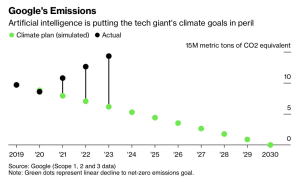Google has stopped buying cheap carbon offsets that previously supported its carbon neutrality claim. The company, facing increased emissions due to artificial intelligence and data centers’ massive power use, now aims for net zero carbon by 2030.
Since 2007, the tech giant claimed carbon neutrality by purchasing offsets to match emissions from its operations. However, their latest report states:
“Starting in 2023, we’re no longer maintaining operational carbon neutrality.”
The shift marks a move towards more substantial emission reductions and advanced carbon removal solutions.
Google’s Approach to 2030 Net Zero Goal
In 2021, Google set an ambitious target to achieve net zero emissions across all operations and value chains by 2030. This includes reducing 50% of Scope 1, Scope 2, and Scope 3 emissions from a 2019 baseline, and investing in nature-based and technology-based carbon removal solutions to neutralize the rest.
The Science Based Targets initiative (SBTi) will validate Google’s absolute emissions reduction target.
Google’s net zero goal aligns with the IPCC’s definition and will adapt as global standards evolve, aiming to balance anthropogenic emissions with removals while maximizing positive planetary impact.
Achieving net zero emissions involves navigating significant uncertainties, including the environmental impact of AI and the clean energy transition. The Big Tech anticipates an initial rise in total greenhouse gas emissions before reductions align with the net zero goal.
In 2023, Google’s GHG emissions were 14.3 million tCO2e, a 13% year-over-year increase and 48% higher than in 2019, driven in part by a 37% rise in Scope 2 (market-based) emissions.

The rise was also mainly due to increased data center energy consumption and supply chain emissions. Integrating AI into products poses further challenges, as the energy demands and emissions associated with AI are expected to grow. Below is Google’s data center carbon-free energy (CFE) map.
Google CFE Map

Despite the GHG emissions increase, the overall growth rate of emissions slowed compared to previous years. Key emissions trends are:
Emissions reductions:
- All Scope 1, 2 (market-based), and 3 absolute emissions across operations and value chain increased in 2023.
- This includes emissions from data centers, office operations, supply chains, and consumer hardware devices.
Residual emissions:
- 2023 marked the initiation of the tech company’s carbon removal strategy.
- Google is in the early stages of establishing impactful partnerships and have begun contracting for carbon removal credits.
Google’s Carbon Credits Strategy
Google aims to neutralize its residual emissions with high-quality carbon credits by 2030. Starting in 2023, the search engine firm shifted its strategy from maintaining operational carbon neutrality to accelerating various carbon solutions and partnerships.
As seen in the chart below from Bloomberg, Google’s carbon offsets plummeted to zero in 2023, from 3 million tons of carbon credits.

The goal now is to play a significant role in advancing both nature-based and technology-based carbon removal solutions to mitigate climate change.
To support the advancement of carbon removals, Google addresses the key challenges these solutions face. Technology-based solutions, for instance, currently lack scale and are often expensive, operating mostly as small pilots. To tackle this, the company pledged $200 million in 2022 to Frontier, an advance market commitment aimed at accelerating carbon removal technologies by guaranteeing future demand.
In 2023, Google completed its first carbon credit offtake deals through Frontier, including agreements with Charm Industrial, CarbonCapture, and Lithos Carbon.
Another challenge is the reluctance of corporations to participate in the nascent carbon removal market. Google believes governments and companies must play complementary roles in demonstrating and scaling promising carbon removal approaches.
In March 2024, Google pledged to match the U.S. Department of Energy’s Carbon Dioxide Removal Purchase program dollar for dollar. The tech giant plans to contract at least $35 million in carbon removal credits over the next 12 months.
Advancing Carbon Removals
Google is committed to working with partners to identify and scale promising carbon removal solutions, hoping other companies will join the effort.

In addition to these partnerships, Google.org provided a $1 million grant in 2023 to the Integrity Council on Voluntary Carbon Markets (ICVCM) to support high-integrity solutions. This grant brought Google.org’s total contributions to strengthening carbon markets to over $7 million. This fund supports organizations like The Gold Standard, Rocky Mountain Institute, the Voluntary Carbon Market Initiative, and Climate Action Data Trust.
Beyond purchases and partnerships, Google drives advancements in research and technology. In 2023, the company introduced the Google Carbon Removal Research Awards, providing over $3 million in funding to universities and academic research institutions.
These funds support scientific studies on carbon removals, including the effects of ocean alkalinity enhancement on coastal ecosystems and the potential of enhanced weathering projects in forests.
By the end of 2023, Google signed three carbon credit offtake deals, purchasing around 62,500 tCO2e of removal credits, contracted for delivery by 2030. Google recognizes this as just the beginning and is committed to accelerating its carbon removal efforts in the years to come, continually evolving its approach to counterbalance its residual emissions.

